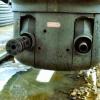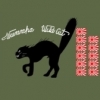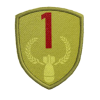Parani Aviation Company YG/1 'Goshawk' - 1st Training Air Regiment, Parani Army Air Force, 1939
In 1919 British geologists discovered oil reserves located in the Mazadran area straddling the River Kerman which for many centuries had been recognised as defining the border between the neighbouring Arab nations of Dhimar and Paran. The British government quickly negotiated permissions to drill on the Dhimari side of the Kerman Valley setting up the Anglo-Dhimari Oil Company and in 1921 drilling operations followed.
However, in January 1928 Shah Mushani of Paran sent his army across the border in an attempt to capture the Mazadran oil fields but this was repelled by Dhimari forces bolstered by UK forces drawn in from Persia. In particular, the RAF inflicted severe losses on Parani forces and were subsequently largely responsible for preventing any resurgence with 'air policing' tactics that saw the constant harassment of Parani forces and Parani settlers in the Kerman Valley. Over the next two years Dhimar becomes a wealthy and economically powerful country whilst Paran has become poor.
By the middle of 1930 Shah Mushani of Paran had stopped his attempts to capture the Mazadran oil fields and focused on re-building his domestic power base by the ruthless eradication of his political opponents after which he had absolute control of his political party and government. In early 1931 Mushani announced a five year plan to strengthen his armed forces by expansion allied to an ambitious domestic arms production programme including the creation of an indigenous aviation industry. In June 1931, Shah Mushani announced the creation of the Parani Aviation Company who were tasked with three aircraft projects of increasing complexity; a light-attack aircraft that could also serve as a trainer, a tactical bomber and a single-seat fighter aircraft. To kick start these projects, Mushani appoints Nikolai Yergin as the chief designer of the Parani Aviation Company giving Yergin licence to recruit several other Russian engineers including Vladimir Gudkov from the OKB-301 design bureau.
For the light attack aircraft Yergin and Gudkov schemed the YG/1 a two-seat, single-engined biplane with a tubular steel framework covered with fabric. This was a conservative design but probably the right choice for an embryonic aircraft company in 1932. The prototype YG/1 was completed by late 1933 but it's first flight was delayed due to problems with the Italian supplied Alfa Romeo D2 nine-cylinder radial engine. The first flight of the YG/1 took place on February 1st, 1934 with it's designer Nikolai Yergin at the controls and after a series of successful trials production began later in 1934 and 36 aircraft were built over a period of nearly three years.
Entering service with the 1st Training Air Regiment of the Parani Army Air Force in September 1935 this versatile but pedestrian aircraft served as a trainer, close air support aircraft and army liaison aircraft with the final examples finally being removed from the Parani Army Air Force inventory in December 1949.
Skin Credit: Charles














